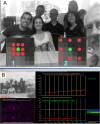Reading and Myopia: Contrast Polarity Matters
- PMID: 30022043
- PMCID: PMC6052140
- DOI: 10.1038/s41598-018-28904-x
Reading and Myopia: Contrast Polarity Matters
Abstract
In myopia the eye grows too long, generating poorly focused retinal images when people try to look at a distance. Myopia is tightly linked to the educational status and is on the rise worldwide. It is still not clear which kind of visual experience stimulates eye growth in children and students when they study. We propose a new and perhaps unexpected reason. Work in animal models has shown that selective activation of ON or OFF pathways has also selective effects on eye growth. This is likely to be true also in humans. Using custom-developed software to process video frames of the visual environment in realtime we quantified relative ON and OFF stimulus strengths. We found that ON and OFF inputs were largely balanced in natural environments. However, black text on white paper heavily overstimulated retinal OFF pathways. Conversely, white text on black paper overstimulated ON pathways. Using optical coherence tomography (OCT) in young human subjects, we found that the choroid, the heavily perfused layer behind the retina in the eye, becomes about 16 µm thinner in only one hour when subjects read black text on white background but about 10 µm thicker when they read white text from black background. Studies both in animal models and in humans have shown that thinner choroids are associated with myopia development and thicker choroids with myopia inhibition. Therefore, reading white text from a black screen or tablet may be a way to inhibit myopia, while conventional black text on white background may stimulate myopia.
Conflict of interest statement
The authors declare no competing interests.
Figures



References
Publication types
MeSH terms
LinkOut - more resources
Full Text Sources
Other Literature Sources
Miscellaneous

